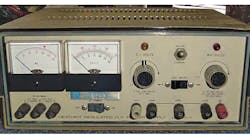>> Electronic Design Resources
.. >> Library: Article Series
.. .. >> Topic: Looking Back at Electronic History
.. .. .. >>Series: Rise and Fall of Radio Shack and Heathkit
Those of us who worked at Heathkit in its prime visit with one another from time to time to discuss the good-old-days. For example, my friend and colleague Chas Gilmore and I recently discussed the final closing of the last vestige of Heathkit in May. With the DIY and kit businesses seemingly doing well these days, why did Heathkit close? The reasons were business and market related. Chas explained it well in a recent note that I quote below.
“Heathkit was a business that started and thrived as a “right-time, right-place” business. It reached end-of-life when markets evolved to a point it became unsustainable as a corporate entity.
The company was born at the end of World War II when tens of thousands of GIs and civilians who were trained in the emerging world of electronics, a technology that exploded to support the war effort, returned to peacetime activity. They were hungry for electronic products, and they were very willing to exchange pleasurable sweat-equity (i.e., their time) for a substantial reduction in the cost to acquire them.
Their knowledge of this new technology made them respected and admired members of society. Low-cost military components helped keep costs down. (For example, a $37.50 5-in. oscilloscope). Customers also accepted reductions in functions, features, and specifications for lower cost.
So what changed? By the late 1970s, the electronics market had grown substantially, especially consumer electronics. Everybody had multiple electronic products in their home. Even Grandma could program her VCR.
Discretionary income increased and manufacturing costs plunged, so compromises in features, functions, and specifications were no longer acceptable. Labor decreased as a percentage of the manufacturing cost (versus a substantial or dominant percentage at the birth of Heathkit). The trade of sweat-equity for lower cost disappeared.
Other changes included the emergence of personal computers in the 1980s, shifting consumer interest from hardware to software. Family focus evolved drastically too, reducing the principal customer’s (male, head-of-household) time for self-absorbing hobbies. The average workweek increased, cutting available personal time. And, dual-income families decreased available personal time.
All of these factors worked to move kit-building in the mid-1980s to late-1980s from a hobby with cost savings for a broad range of products appealing to the “techie” 2% of the population to a niche market viable for smaller companies—a business model not sustainable for a large division of a large corporation. “
Chas Gilmore left Heath in the early 1990s as Executive VP and General Manager when parent company Zenith decided to close the kit business and focus on the personal computer market. Chas’s current affiliation is Managing Partner, PPM, Inc.
Chas and I had the pleasure of starting the kit computer business at Heath in the early and mid-1970s. Microprocessors were still a new thing and a good number of kits were showing up in the hobby magazines (MITS Altair, IMSAI, Southwest Micro, etc.) We figured we had to do something. Both of us came to it from a Digital Equipment Corporation (DEC) computer background and we thought the Holy Grail was to put a PDP-8 into kit form at an affordable price. Instead we basically decided between the Intel 8080 and the Motorola 6800 processors. We ended up with two kit computers, the H8 with an 8080 processor (Z80 was not there yet) and an octal rather than hex display and keyboard. DEC programmers used octal rather than hex that Intel used and that was our experience. Seemed like the thing to do at the time.
Our second kit computer was the H11 that used the DEC LSI-11 16-bit computer board with some 8-inch disk drives and the RT-11 operating system. Expensive but cool.
We also developed the H9 video terminal and the H10 paper tape reader/punch. The H10 seemed like a good decision at the time although the audio cassette external storage (Remember the Kansas City “standard”?) was more popular until the 5-1/4-inch disk drives became affordable.
The Heathkit computers were launched in 1977 and were an immediate success. It was an approach out of step with the west coast all-in-one designs like the Apple I and II, Commodore PET, Atari, TI9900 and Radio Shack TRS-80. Later we did a Z80 all-in-one box called the H89 that was also a big hit and the one that attracted Zenith to Heath. Zenith acquired Heath from Schlumberger in 1979. Zenith continued to build the computer business into Zenith Data Systems while the kit business was essentially ignored to soldier on until it closed in 1992.
So that is the back story. To read more, take a look at our article about Heathkit and the new kids on the block like SparkFun in our October 4th issue. (The Rise and Fall of Heathkit…and the Rise of Sparkfun) You can see it online here and in the print issue.
